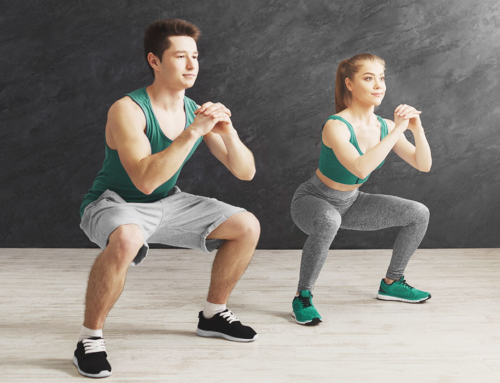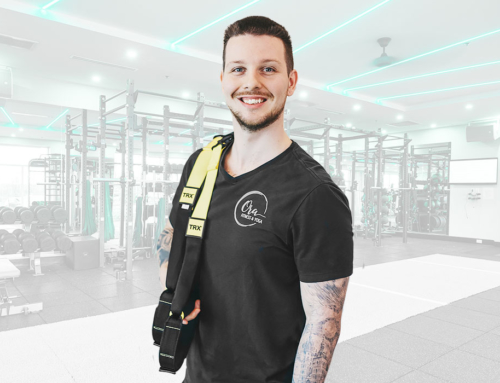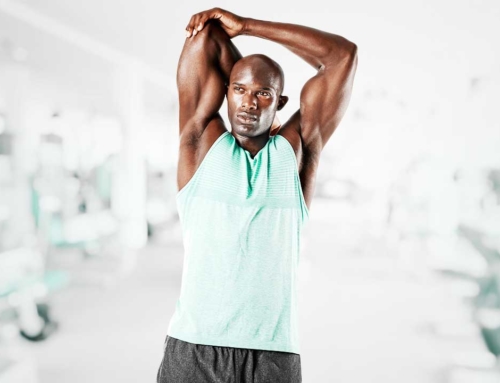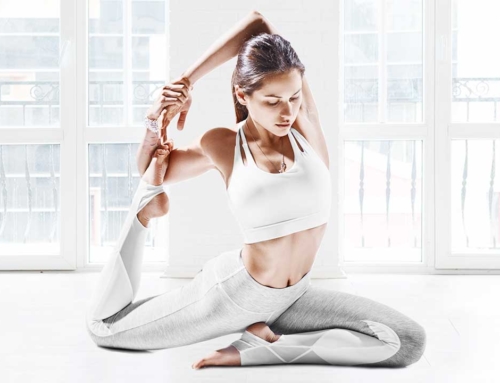A couple of weeks ago I posted my current favourite thoracic rotation exercise that I believe is one of the best in the fitness industry right now.
The reason why I love this exercise is that it completely locks out the lumbar spine from cheating the movement. A common issue with any thoracic rotation exercise is that the lumbar region takes over and causes more harm than good. The set up with this exercise prevents any lumbar rotation and adds a bonus deep hip flexor and oblique stretch that I absolutely love.
Breaking It Down
By setting up in a half kneeling position with your hands interlocked behind your head along with a yoga block against a wall or in this case a cable machine. Then, actively pushing the leg into the yoga block to activate the core, cements you down into a locked out position. Taking a deep breath in and then rotating towards the yoga block you’ll notice your thoracic spine is the only thing moving as you’re actively pushing your leg into the yoga block.
I added a tilt motion at the end of the rotation to have an added deep hip flexor and oblique stretch which I would assume most people would appreciate since we all sit all day. You can easily regress this exercise for anyone dealing with severe shoulder pain by crossing your arms across the body similar to a bodybuilding style of a front squat.
This exercise alone, I firmly believe is one of the best thoracic spine rotation exercises I’ve done in a very long time and think everyone should start incorporating it daily.
The State of Common Pain
With the increasing amount of neck, mid back, and shoulder pain the general population is experiencing as a coach I have to combat this problem with a sniper approach. I have to find rehab/mobility exercises that will give me the most benefit in a short amount of time, as the last thing a client wants to do is be in rehab purgatory.
Personally, starting my business three years ago I never spent that much time on my laptop. Today, I probably spend 80% on my laptop to write blogs, articles, record podcasts, edit videos, answer emails, edit images, etc. I’d consider myself an outlier as fitness professionals tend to take care of their injuries, do their mobility work, train to get strong, nutrition is on point, etc. and my neck and mid back get tight quite often. Can you imagine the regular person that has to sit at a desk 8-10 hours every single day, and has been doing that for the past twenty years and now throw in a smartphone where they are looking down for a couple more hours every day?
Shoulder pain has almost surpassed low back pain in the general population, this says something, and we need to be ready to combat the next wave of pain. You might be asking yourself, “Raf, the title of your blog is about thoracic rotation, why are you talking about shoulder pain?”
The quality of movement dictates the shoulder’s performance and movement quality in the thoracic spine. For our shoulders to be happy and healthy or thoracic spine is the first place where we should focus on to improve the health of our shoulders. So many coaches make the mistake of concentrating on shoulder mobility and stability drills and eventually hit a wall with their clients and patients. The client becomes a little better but still has a slight bit of pain. Rookie mistake…
Think about it. The typical person, sitting at a desk every day for decades. What does their posture look like?
If you got them to reach their hands overhead, would it look pretty? No, not at all.
They would break at the elbows, arch through their lower backs to compensate, and push their head further forward to cheat the movement. Now imagine this individual going to the gym wanting to press overhead, or press in general when in reality he or she should be focusing on thoracic rotation and extension exercises accompanied by some posterior chain work to improve their function.
Now, let’s imagine for a second you’ve improved your thoracic rotation and extension, and you want to start focusing on the shoulders, great! But there’s more to it than throwing a stability ball against the wall and doing figure 8’s to “rehab” your shoulder.
Why is this important?
Remember the body interacts and communicates together as a unit, and there’s usually more than just one thing to work on. Now, that we are on our shoulders and still experiencing pain, most likely, we should focus on our scapulas.
Many clients and patients dealing with anterior shoulder pain, 9/10 times when I help them improve their scapular movement their shoulder pain goes away.
If we look at the scapulas and what they do, they should be able to elevate, depress, rotate upwards, rotate downwards, protract and retract. For our scapulas to do these movements, seventeen intrinsic muscles allow our scapulas to move, yes seventeen!
We Have:
Serratus Anterior, Supraspinatus, Subscapularis, Trapezius, Teres Major, Teres Minor, Triceps Brachii long head, Biceps Brachii, Rhomboid Major, Rhomboid Minor, Coracobrachialis, Omohyoid inferior belly, Lattisimus Dorsi, Deltoid, Levator Scapula, Infraspinatus, Pectoralis Minor
This long list goes to show what needs to happen for our shoulder blades to move pain-free and efficiently. If one or two of these muscles don’t function correctly the others have to take up the workload, and over time will build up stress and something will have to go. You combine this with poor thoracic rotation and extension; you have a recipe for disaster.
What I see with clients and patients is complaints of anterior shoulder pain. They will point at the front of their shoulders and explain how painful any movement is. My first step is to evaluate everything around that anterior shoulder pain, and TWO things usually pop up for everyone I see. They have poor thoracic rotation both left and right, along with the limited extension. Then, I check how the scapulas work. A simple controlled overhead reach and descend can demonstrate truth scapular motion of an individual.
If the scapulas don’t glide easily and smoothly most likely, there are a few of the seventeen intrinsic stabilizer muscle not “firing” adequately to perform proper scapular rhythm. After I check their scapulas, I test their thoracic rotation. When thoracic rotation is limited, our bodies will pick up that rotation from two places, the lumbar spine, or our shoulders.
When I see this with my clients and patients, I start programming thoracic rotation exercises along with scapular stability exercises.
Favourite Mobility Drills
Along with the video above, these are my next three favourite thoracic spine mobility drills:
Kneeling T Spine Rotation, Half Kneel T Spine Rotation, Open Books
Then, here are my three favourite scapular stability drills:
Quadruped Scapular CARS, Foam Roller Scapular Wall Slides, Band Scapular Retractions
Combining these exercises you will build some strong and resilient scapulas that function optimal and eventually relieve some aches and pains in that anterior shoulder!










Leave A Comment